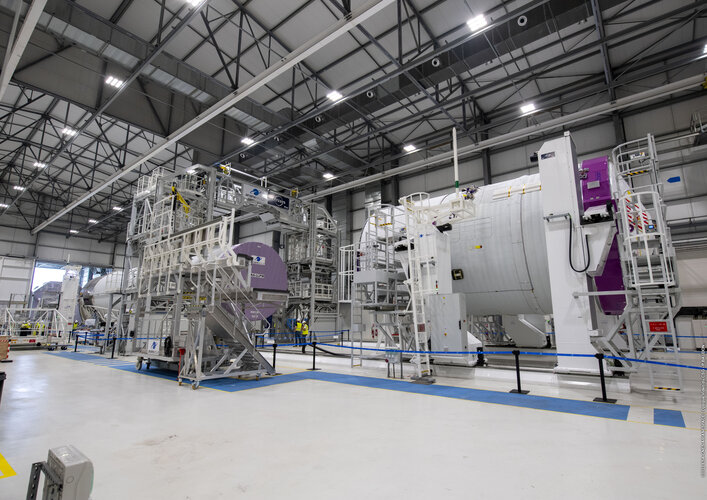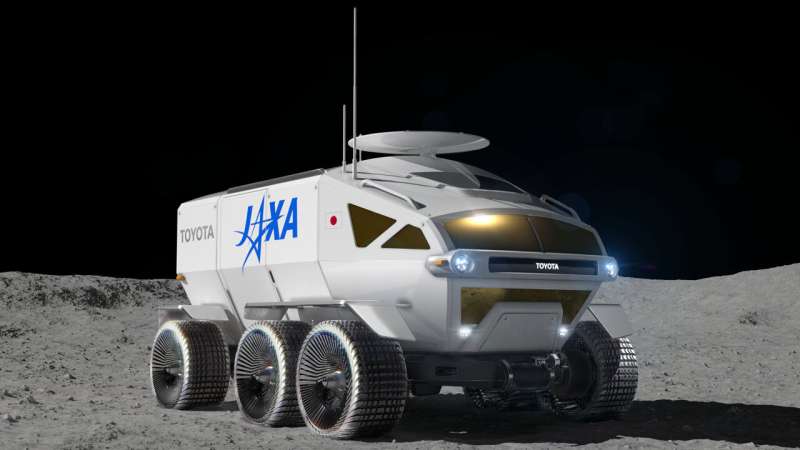
Copernical Team
Ariane 6 central core set for assembly

The lower stage of ESA’s next-generation Ariane 6 launch vehicle has been installed on the assembly line at Europe’s Spaceport behind the upper stage. It is now time to join the two horizontally to create the central core of Ariane 6 in readiness for the first combined tests on the launch pad.
Crater tree rings
 Image:
Crater tree rings
Image:
Crater tree rings Toyota heading to moon with cruiser, robotic arms, dreams

China welcomes intl cooperation in space station, explorations: White paper
 China will employ its space station for carrying out astronomical observations, Earth science and research, and space science experiments in the next five years, according to a white paper published Friday.
The white paper, titled "China's Space Program: A 2021 Perspective", was released by China's State Council Information Office.
The country plans to complete the construction of it
China will employ its space station for carrying out astronomical observations, Earth science and research, and space science experiments in the next five years, according to a white paper published Friday.
The white paper, titled "China's Space Program: A 2021 Perspective", was released by China's State Council Information Office.
The country plans to complete the construction of it China to explore more in space science next five years: White paper
 China will carry out more space science exploration in the next five years, according to a white paper on the country's space activities released Friday.
The white paper, titled "China's Space Program: A 2021 Perspective," was released by the State Council Information Office.
It says that China will continue with the research and development of programs such as the satellite for spac
China will carry out more space science exploration in the next five years, according to a white paper on the country's space activities released Friday.
The white paper, titled "China's Space Program: A 2021 Perspective," was released by the State Council Information Office.
It says that China will continue with the research and development of programs such as the satellite for spac What wintering squirrels can teach astronauts
 When bears and ground squirrels hibernate in winter, they stop eating, lasting until spring simply on the fat reserves they've stored up in their bodies. Usually, this sort of prolonged fasting and inactivity would significantly reduce the mass and function of muscle, but hibernators don't suffer this fate. How they avoid it, however, has been a mystery.
Now, in research published in Scien
When bears and ground squirrels hibernate in winter, they stop eating, lasting until spring simply on the fat reserves they've stored up in their bodies. Usually, this sort of prolonged fasting and inactivity would significantly reduce the mass and function of muscle, but hibernators don't suffer this fate. How they avoid it, however, has been a mystery.
Now, in research published in Scien Space Power to revolutionize satellite power using laser beaming
 The University of Surrey and Space Power are tackling the problem of powering satellites in Low Earth Orbit (LEO) during their eclipse period when they cannot see the sun. By collaborating on a space infrastructure project, the joint team will develop new technology which uses lasers to beam solar power from satellites under solar illumination to small satellites orbiting closer to Earth during
The University of Surrey and Space Power are tackling the problem of powering satellites in Low Earth Orbit (LEO) during their eclipse period when they cannot see the sun. By collaborating on a space infrastructure project, the joint team will develop new technology which uses lasers to beam solar power from satellites under solar illumination to small satellites orbiting closer to Earth during NASA aims to make observations from space junk collision with Moon
 NASA said Thursday it aims to survey the crater formed when the remains of a SpaceX rocket are expected to crash into the Moon in early March, calling the event "an exciting research opportunity."
The rocket was deployed in 2015 to put a NASA satellite into orbit and its second stage, or booster, has been floating in the cosmos ever since, a common fate for such pieces of space technology.
NASA said Thursday it aims to survey the crater formed when the remains of a SpaceX rocket are expected to crash into the Moon in early March, calling the event "an exciting research opportunity."
The rocket was deployed in 2015 to put a NASA satellite into orbit and its second stage, or booster, has been floating in the cosmos ever since, a common fate for such pieces of space technology. Hat-trick for Exolaunch with SpaceX Transporter Missions
 In its third dedicated rideshare mission with SpaceX, Exolaunch, the leading global provider of launch, in-space logistics and deployment services, successfully integrated and launched 29 small satellites from customers across the globe. The company's rideshare clusters aboard the SpaceX Transporter-3 mission were an amalgamation of microsats, cubesats (up to 16U) and PocketQubes. The combinatio
In its third dedicated rideshare mission with SpaceX, Exolaunch, the leading global provider of launch, in-space logistics and deployment services, successfully integrated and launched 29 small satellites from customers across the globe. The company's rideshare clusters aboard the SpaceX Transporter-3 mission were an amalgamation of microsats, cubesats (up to 16U) and PocketQubes. The combinatio CU Boulder scientists bring stellar flares into clearer focus
 Armed with a new statistical analysis of stellar flares on hundreds of distant stars, scientists are beginning to understand the likelihood that remote "exoplanets" might sustain life in our galaxy, research at the University of Colorado Boulder suggests.
The most-intense flares, which are more complex than previously observed, could have implications for the viability of life on nearby pl
Armed with a new statistical analysis of stellar flares on hundreds of distant stars, scientists are beginning to understand the likelihood that remote "exoplanets" might sustain life in our galaxy, research at the University of Colorado Boulder suggests.
The most-intense flares, which are more complex than previously observed, could have implications for the viability of life on nearby pl 































